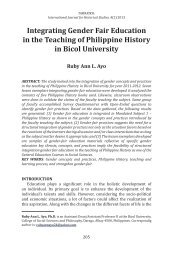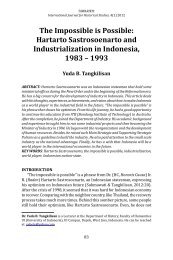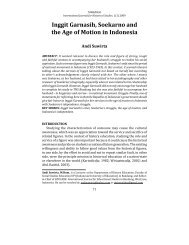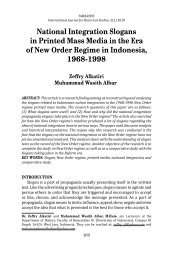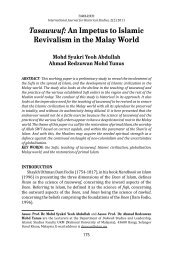Illustration on Javanese Manuscripts: The ... - Tawarikh Journal
Illustration on Javanese Manuscripts: The ... - Tawarikh Journal
Illustration on Javanese Manuscripts: The ... - Tawarikh Journal
You also want an ePaper? Increase the reach of your titles
YUMPU automatically turns print PDFs into web optimized ePapers that Google loves.
TAWARIKH:Internati<strong>on</strong>al <strong>Journal</strong> for Historical Studies, 1(2) 2010<str<strong>on</strong>g>Illustrati<strong>on</strong></str<strong>on</strong>g> <strong>on</strong> <strong>Javanese</strong> <strong>Manuscripts</strong>:<strong>The</strong> Intellectuality and the Capabilityof Thinking into Ind<strong>on</strong>esian Art andWriting CultureNuning Y. Damayanti Adisasmito 1ABSTRACT: <strong>The</strong> traditi<strong>on</strong> of writing and drawing in illustrati<strong>on</strong> was found in theold manuscript. Some parts of those old manuscripts show unique illustrati<strong>on</strong>s aswell as the local identity of Nusantara’s society. <strong>The</strong> manuscript relects the societyculture of thinking and aesthetic achievement of visual art. <strong>The</strong> illustrati<strong>on</strong>s of old<strong>Javanese</strong> manuscripts were well documented and has various representati<strong>on</strong> invisualizati<strong>on</strong> art and style, drawing method, theme, and visual objects, even thoughthe visualizati<strong>on</strong> of the visual c<strong>on</strong>cepts is practically similar to another. It relectsthe structured illustrati<strong>on</strong> and style as well as expressi<strong>on</strong> symbol of the <strong>Javanese</strong>society in that era. <str<strong>on</strong>g>Illustrati<strong>on</strong></str<strong>on</strong>g> of the old <strong>Javanese</strong> manuscript in the col<strong>on</strong>ial erahas changed and developed its visual state as the interacti<strong>on</strong> between the Animismin the Pre-Hinduism era, cultural paradigm of Hinduism-Buddhism, Islamic andCol<strong>on</strong>ialism.KEY WORDS: writing traditi<strong>on</strong>, illustrati<strong>on</strong> traditi<strong>on</strong>, col<strong>on</strong>ialism, and old <strong>Javanese</strong>manuscript.INTRODUCTION<strong>Manuscripts</strong> are artefacts recording culture achievement and thinkingenrichment of a nati<strong>on</strong> and are the sources of culture knowledge of thepast. Every people in the world has old valuable manuscripts – which areimportant records <strong>on</strong> the existence of a nati<strong>on</strong> – and so do the Ind<strong>on</strong>esians.Ind<strong>on</strong>esian ancestors recorded their culture of the past <strong>on</strong> various kinds ofmanuscripts, spread in the whole country of Ind<strong>on</strong>esia. <strong>The</strong> number anddiversity of the manuscripts show that Ind<strong>on</strong>esians are the people havingthe intellectuality and the capability of expressing ideas, thoughts, andDr. Nuning Y. Damayanti Adisasmito is a Lecturer at the Faculty of Fine Art and DesignITB (Bandung Institute of Technology), Jalan Ganesha 10 Bandung, West Java, Ind<strong>on</strong>esia.She can be reached at: aryasena@bdg.centrin.net.id123
NUNING Y. DAMAYANTI ADISASMITO,<str<strong>on</strong>g>Illustrati<strong>on</strong></str<strong>on</strong>g> <strong>on</strong> <strong>Javanese</strong> <strong>Manuscripts</strong>culture of thinking into writing. <strong>The</strong> society culture of expressing ideas andthinking is wrapped in various kinds of manuscripts – some of which areexpressed in ornaments, illuminati<strong>on</strong>s, and illustrati<strong>on</strong>s (Florida, 1995).<strong>The</strong>se drawings show unique and typical visualizati<strong>on</strong> adjusted to thebackground of the society and the their functi<strong>on</strong>s.<strong>The</strong> writing culture of the <strong>Javanese</strong> has been c<strong>on</strong>sensus for ages. Thiscan be proven from the fact that manuscript artefacts can still be tracedfrom the periods of the beginning of such <strong>Javanese</strong> kingdoms as Majapahit,Pajang, Demak, Surakarta, and Yogyakarta. Some manuscripts relectillustrati<strong>on</strong>s, and are well documented in both Ind<strong>on</strong>esian and overseaslibraries (Yudosaputro, 1998b). Modernizati<strong>on</strong>, however, has made thesevaluable manuscripts uncomprehensible for the young generati<strong>on</strong> today.To trace the creati<strong>on</strong> of <strong>Javanese</strong> manuscripts, we cannot put theircorrelati<strong>on</strong> to the visual art of leather puppets aside, because we can drawan analogy between the stories of the shadow plays and those of importantevents of the kingdoms and their kings. <strong>The</strong> development of <strong>Javanese</strong> culture,therefore, can be c<strong>on</strong>sidered to be parallel to the puppet stories (Moebirman,1960). Comprehending the plot of the stories and their characters is anattempt to understand the characters and life philosopy of the <strong>Javanese</strong>.<strong>Javanese</strong> manuscripts which can still be appreciated are those of the 18 thand the begining of the 20 th centuries. <strong>The</strong>y relect the stories of periodsof the Majapahit kingdom which then change and develop because of theadaptati<strong>on</strong> of Islamic norms. Accordingly, in tracing the creati<strong>on</strong> of themanuscripts of those eras, we cannot ignore either the role of Islam religi<strong>on</strong> orthe political factors of the <strong>Javanese</strong> supremacy. According to John Pembert<strong>on</strong>in his book, On the Subject of Java (1994), most manuscprits written at theseperiods are about the effects of Dutch col<strong>on</strong>ialism towards <strong>Javanese</strong> culture,especially those of <strong>Javanese</strong> kingdoms (Surakarta and Yogyakarta). Some ofthe manuscripts of 19 th centuries relecting illustrati<strong>on</strong>s likely representcultural phenomena of those eras. <strong>The</strong>y are, therefore, history records and<strong>on</strong>e the artefacts is necessarily to understand and investigate.JAVANESE MANUSCRIPTS AS CULTURE PRODUCTS ANDCOMPREHENDING MANUSCRIPTS AND WRITING TRADITIONIN JAVAArt is a culture product which become <strong>on</strong>e of the parameters todetermine the values of a society. Art should represent sense or valuesand have visualisati<strong>on</strong>. This kind of art product is a bunch of inheritencesof comprehensible art works based <strong>on</strong> the society comprehensi<strong>on</strong> of thatera (Kempres, 1959).124
TAWARIKH:Internati<strong>on</strong>al <strong>Journal</strong> for Historical Studies, 1(2) 2010C<strong>on</strong>sidering various kinds of functi<strong>on</strong>s and background of art products,the creati<strong>on</strong> of <strong>Javanese</strong> old manuscripts should be c<strong>on</strong>sidered as aphenomen<strong>on</strong> in the culture which can be investigated based <strong>on</strong> culturetheories of Koentjaraningrat (1997) and <strong>on</strong> 3 other accompanying formsof cultures, divided as follows: (1) <strong>Javanese</strong> manuscripts as a record ofideas, thoughts, and c<strong>on</strong>tent of thinking are illustrati<strong>on</strong> of <strong>Javanese</strong> cultureschemes or ideas; (2) <strong>Javanese</strong> manuscripts are a representati<strong>on</strong>s ofvarious kinds of social-life activities; and (3) <strong>Javanese</strong> manuscripts aremeans of life senses and values which are in the form of book artefactsrelecting high achievement of <strong>Javanese</strong> intelectuality in writing and visualart or practices.In creating something human beings are generally inspired by existingfactors, and so were old art practici<strong>on</strong>ists in Java. <strong>The</strong>ir creativity is based <strong>on</strong>“knowledge” and existing art works of the past. In this research, knowledgemeans “traditi<strong>on</strong>” – which is a bunch of inheritances <strong>on</strong> what and howart works are created based <strong>on</strong> the society interpretati<strong>on</strong> of that era. <strong>The</strong>development of <strong>Javanese</strong> visual art since pre Hinduism, Hinduism-Buddhism,Islamic, and col<strong>on</strong>ialism eras is basically the development of culture andaesthetic achievement referring to the needs of the society of that era.<strong>Javanese</strong> manuscripts are important records and generally havehistorical values. Most of them which have been changed and adopted,especially those of 19 th centuries, are recompositi<strong>on</strong> products and are inthe forms of traditi<strong>on</strong>al s<strong>on</strong>gs called macapat. Most of them were written150 years ago, during the end of col<strong>on</strong>ialism era till the beginning ofInd<strong>on</strong>esian Independence Revoluti<strong>on</strong> era. <strong>The</strong>y are written by those whohave str<strong>on</strong>g correlati<strong>on</strong> to <strong>Javanese</strong> kingdom society. Some of them includdrawings such as illustrati<strong>on</strong>s which are visual art products of the <strong>Javanese</strong>(Ossenbruggen, 1975).Writing is a highly supported activity, and the authors of that era areintelectuals who are strategically capable of recording sociopolitical genres,not <strong>on</strong>ly representing about future predicti<strong>on</strong>s but also putting them intoreality. Penulis (Authors) in <strong>Javanese</strong> traditi<strong>on</strong> are active practi<strong>on</strong>istsin authority and are authorized for full freedom. <strong>The</strong> word Penulis in<strong>Javanese</strong> society comes from <strong>Javanese</strong> language, panulis or penyerat – i.e.those who are physically write a manuscript. An author is a composer(panganggit, pangiket) who textually and productively arranges (nganggit)and structures (ngiket) the words or texts. He is also the <strong>on</strong>e who is able tointerprete and then describe, colour, edit, and structure with nedhak – i.e. afreedom of arranging the words in rewriting (nurun, nedhak) a manuscriptto become a new versi<strong>on</strong> with a new c<strong>on</strong>text (Schoemaker, 1924).125
NUNING Y. DAMAYANTI ADISASMITO,<str<strong>on</strong>g>Illustrati<strong>on</strong></str<strong>on</strong>g> <strong>on</strong> <strong>Javanese</strong> <strong>Manuscripts</strong>A. <strong>The</strong> Development and Role of <strong>Manuscripts</strong> in <strong>Javanese</strong> Society<strong>The</strong> illustrati<strong>on</strong> of <strong>Javanese</strong> writing traditi<strong>on</strong> has a str<strong>on</strong>g correlati<strong>on</strong> toold stuffs, so that to understand the culture of <strong>Javanese</strong> visual art shouldbe relevant to understanding Java of the past time. For example, the oldesttranslati<strong>on</strong> of Ramayana into <strong>Javanese</strong> macapat was written in 903 AC(After Christ), and Mahabharata in the era of Prabu Darmawangsa in 991– 1007 AC (Muly<strong>on</strong>o, 1977:182-184). <strong>The</strong> manuscript of Kakawin ArjunaWiwaha, in the 11 th century composed by Mpu Tantular c<strong>on</strong>tains <strong>Javanese</strong>spiritual less<strong>on</strong>s wrapped in Hinduism puppet stories, and is an analogyof describing the struggles of the kings at that era. In the 12 th century,Mahabharata Epos was reinterpreted according to the c<strong>on</strong>diti<strong>on</strong> and normsof <strong>Javanese</strong> literatures. It was then localized and recomposed for shadowpuppet shows c<strong>on</strong>taining symbols of <strong>Javanese</strong> spiritual less<strong>on</strong>s (Serat DewaRuci and Serat Arjuna Wiwaha) relecting syncretism and acculturati<strong>on</strong>of <strong>Javanese</strong> and Hindu cultures. This manuscript was rewritten by MpuSedah and has become a reference of puppet stories and their varietiesuntil now. Hindu Classic <strong>Javanese</strong> Literary Art occurred during the era ofHindu-Buddha.<strong>The</strong> most popular manuscripts telling about the golden era of Majapahitare Pararath<strong>on</strong> written by Mpu Tantular and Negarakertagama by MpuPrapanca. Both describe the c<strong>on</strong>diti<strong>on</strong> of the golden reign of Majapahitwhich is in accordance with Hindu and Buddha in both complexity andharm<strong>on</strong>y paradigm. C<strong>on</strong>cepts of king Gods and Gods of Buddha-Mahayanain the Hindu <strong>Javanese</strong> kingdom and Islamic eras give huge inluences to thepresent politics and governance in Java. This is relected in the manuscripts<strong>on</strong> the royal family tree which always put gods at the irst level of the tree.Palaces are the centres of the spiritual power inluencing the life of thesociety, and of the royal governance and residences (Mulder, 2005).When Islam reached Java, Islamisati<strong>on</strong> by Moslem intelectuals occurredand the quality and spirituality of religious activities increased. This canbe seen in the development of transformative c<strong>on</strong>cepts, relected in theold <strong>Javanese</strong> manuscripts of the 19 th century. Egalitarian system of Islamsucceeded in fading the differences between the hierarchies of Majapahitkingdom. Harm<strong>on</strong>ious Islam suic and mystical way of thinking acculturateswith local mystism str<strong>on</strong>gly derived from the traditi<strong>on</strong> of <strong>Javanese</strong>. Islameducati<strong>on</strong> system providing Pesantren (Islamic boarding schools), insteadof Padepokan (dormitories) in the Hindu era, plays an important role inproliferating Islam religi<strong>on</strong>. Pesantren, which is still well know until now,is also a place where the culture of reading and writing was introducedand fast developed. This brings about the development of the culture of126
TAWARIKH:Internati<strong>on</strong>al <strong>Journal</strong> for Historical Studies, 1(2) 2010books and manuscripts written c<strong>on</strong>gruent with Islam. Rewriting the HolyKoran and Hadists leads to the development of calligraphy and mushaf.That was the time when Islamic culture and Ind<strong>on</strong>esian intelectualityreached the top, when literacy of Arabic, local languages, and Malay wasmade possible for the society, and when illuminati<strong>on</strong>s and illustrati<strong>on</strong>swere made possible after the introducti<strong>on</strong> of daluang paper (Ali, 1994;and Yudosaputro, 1998a).B. C<strong>on</strong>diti<strong>on</strong>s of Socio-Culture <strong>on</strong> the Col<strong>on</strong>ialism EraDiscrepancies <strong>on</strong> the development of art and culture occured at thebeginning of the 17 th to the middle of the 18 th centuries as a result of theDutch’s devide et impera politics. This c<strong>on</strong>diti<strong>on</strong> brought about civil warsam<strong>on</strong>g <strong>Javanese</strong> kings and rebelli<strong>on</strong>s towards the Ducth government whichoccured l<strong>on</strong>ger than 1 century. In additi<strong>on</strong>, this period result in otherimportant events leading to the change of the hierarchy of the <strong>Javanese</strong>society. For exampe, in 1740 the Chinese ethnic group rebelled. <strong>Javanese</strong>Successei<strong>on</strong> War (1746–1757), Giyanti Agreement in 1755 stopped thewar am<strong>on</strong>g Mataram kings, which resulted in the divisi<strong>on</strong> of Mataramkingdom into small kingdoms: Surakarta and Yogyakarta. Blambangan kingsalso fought to each other, and the last war was Java War led by PangeranDip<strong>on</strong>egoro (1825–1830), and many other events (Simbol<strong>on</strong>, 2006).At the same time, global politic crisis attacked Europe as a result of theFrench revoluti<strong>on</strong>. This crisis indirectly inluenced European col<strong>on</strong>ies inAsia, leading to the c<strong>on</strong>lict am<strong>on</strong>g Europeans in Asia. It also caused thechanging in political strategies of West col<strong>on</strong>ialisati<strong>on</strong> in Asia regi<strong>on</strong>s andthe changing in the Dutch government in Java. In additi<strong>on</strong>, another crisishappened in 1799, when VOC (Vereneegde Oost-Indische Compagnie orDutch East India Company) was stipulated bankrupt and was eventuallydispersed, and then Ind<strong>on</strong>esia was taken over by the Dutch kingdom. It wasat this transiti<strong>on</strong> period when Ind<strong>on</strong>esian nati<strong>on</strong>alism emerged (Lombard,1996). At the same century, moderate Islamic culture regained its peak inInd<strong>on</strong>esia, inluencing the way of thinking of the <strong>Javanese</strong>.<strong>The</strong> transiti<strong>on</strong> of VOC to the government of the Dutch Royal in 1799–1800 and the global socio-politic c<strong>on</strong>diti<strong>on</strong> in Europe during the Frenchrevoluti<strong>on</strong>, <strong>on</strong> the resp<strong>on</strong>sibility of Daendels, made the French col<strong>on</strong>ializeJava. In 1811–1815 <strong>on</strong> the hand of Rafles, the British had a chance to takec<strong>on</strong>trol of Java, and he made a success in applying liberalism. In 1815, theBritish gave the c<strong>on</strong>trol of Java to the Dutch when eventually they succeededin driving Islamic kingdoms in the coastal areas of Java to the hinterland(Pembert<strong>on</strong>, 1994).127
NUNING Y. DAMAYANTI ADISASMITO,<str<strong>on</strong>g>Illustrati<strong>on</strong></str<strong>on</strong>g> <strong>on</strong> <strong>Javanese</strong> <strong>Manuscripts</strong>Moreover, human b<strong>on</strong>dage which changed into Ethic Politics wasc<strong>on</strong>ducted. This politics was identical to the Dutch force labor system(cultuur stelsel) subjected to the <strong>Javanese</strong>. On the other hand, the <strong>Javanese</strong>was directed to adjust their way of thinking to the Dutch way, and someof them were forced to become the Dutch army to ight other Europeancol<strong>on</strong>izers in Asia – the French and British (Ricklefs, 2005).<strong>The</strong> c<strong>on</strong>diti<strong>on</strong> of royal elites and kings was engineered of that sort tobecome a culture pledge of <strong>Javanese</strong> kingdoms (Lombard, 1996). <strong>The</strong>interventi<strong>on</strong> of foreign imperialists made the local elites and aristocrats notto have an attempt in physically ighting back <strong>on</strong> them. <strong>The</strong>y made spiritualand intelectual movement instead of changes towards modernisati<strong>on</strong> ofthinking, and technology development caused the <strong>Javanese</strong> to have widerintelectuality. <strong>The</strong>n there emerged the movement of “modern awareness”which made the <strong>Javanese</strong> had the str<strong>on</strong>g willingness to be independentsociety (Florida, 1995). <strong>The</strong>y poured out their expectati<strong>on</strong> in the art andculture products, <strong>on</strong>e of which was writing manuscripts because of thesupport of the Dutch. <strong>Manuscripts</strong> written at this period were intendedto unite the people to rebuild moral and mental crisis of the <strong>Javanese</strong> as aresult of West materialistic culture and Dutch capitalist system.<strong>The</strong> Dutch applied the culture politic strategy, and since then Europeancol<strong>on</strong>y and the intenventi<strong>on</strong> of the Dutch directly came into the <strong>Javanese</strong>culture. This strategy had changed the way of thinking of the <strong>Javanese</strong>who had been physically and mentally down (Florida, 1995). Kings weredriven to become aristocrats because they no l<strong>on</strong>ger had any military andnaval power. <strong>The</strong>y stopped getting enggaged in politics and this directlyrefrained the society from the communicati<strong>on</strong> with outside world. However,this c<strong>on</strong>diti<strong>on</strong> had spiritually and physically changed and enlightened theirthinking, and had indeed signiicant effects <strong>on</strong> their culture products.<strong>The</strong> Dutch had ordered to study the old Majapahit literary art andrewrite old manuscripts had made the <strong>Javanese</strong> intelectuals effectivelyuse the chances for spiritual movements in developing their culture. <strong>The</strong>ywere also encouraged to write more literary art works and resulted inthe rise of <strong>Javanese</strong> literary art. <strong>The</strong> translati<strong>on</strong> of foreign literary works,adopti<strong>on</strong> of old literary works, and the producti<strong>on</strong> of new literary worksby kings and their poets noted this era, comm<strong>on</strong>ly called as the Renaisanceof <strong>Javanese</strong> classic literary art.C. <str<strong>on</strong>g>Illustrati<strong>on</strong></str<strong>on</strong>g>s <strong>on</strong> <strong>Javanese</strong> <strong>Manuscripts</strong> as the Relecti<strong>on</strong> of <strong>Javanese</strong>Socio-Culture RealityChanges <strong>on</strong> old manuscript writing make poets, in expressing socialmessages, agree to use modern symbols – i.e. visual languages as modern128
TAWARIKH:Internati<strong>on</strong>al <strong>Journal</strong> for Historical Studies, 1(2) 2010illustrati<strong>on</strong>s adjusted to the changes of their thinking. Those illustrati<strong>on</strong>srelect complexity state and West culture effects. Life values and spiritualreligiousthinking change into profane-capitalist thinking. <strong>The</strong>y still showcosmology of the <strong>Javanese</strong> oriented to palaces and kings as the centres ofsupreme authorities. Kings and aristocrats are still important charactersof the manuscripts. Histories of <strong>Javanese</strong> kings, heroes, and puppet stories– which were not written during the pre-Islam era – are comm<strong>on</strong> themesfor manuscripts illustrated in shadow puppet shows (Tabrani, 1990 and1999).Let’s take Serat Bharatayuda as <strong>on</strong>e of the illustratios. <strong>The</strong> storyexpresses both explicit and implicit messages about the civil war in Java.<strong>The</strong>re are implicit clues as signals and social symbols for the <strong>Javanese</strong>to understand. Culture symbols are also applied in the illustrati<strong>on</strong>s ofmanuscripts. In additi<strong>on</strong>, daily life of the society is <strong>on</strong>e of the themes ofmanuscripts. This shows egalitarian c<strong>on</strong>diti<strong>on</strong> and roles of the societysigniicant in the col<strong>on</strong>ialisati<strong>on</strong> era. Importantly, this c<strong>on</strong>diti<strong>on</strong> indicatesthat the cloud is over the authority of absolute kings as the centre of theuniverse (Fischer, 1990).Serat Bhratayudha, 1902-1903, NN,Collecti<strong>on</strong> of Sana Budaya Library of Krat<strong>on</strong> JogyaFolklores <strong>on</strong> Panji stories remind us <strong>on</strong> <strong>Javanese</strong> cosmologies <strong>on</strong> romanstories about <strong>Javanese</strong> hero-to-prince marriages, which are in fact thesymbols expressing state cosmologies, cosmic marriages between thelower and upper hierarchies. <strong>The</strong>se social symbols state that palaces, i.e.129
NUNING Y. DAMAYANTI ADISASMITO,<str<strong>on</strong>g>Illustrati<strong>on</strong></str<strong>on</strong>g> <strong>on</strong> <strong>Javanese</strong> <strong>Manuscripts</strong>queenisati<strong>on</strong> (mother earth), united with their peoples (<strong>Javanese</strong> society)as the power to gain reigns of kingdom – i.e. the independence of <strong>Javanese</strong>from Dutch col<strong>on</strong>ials. Messages or social signs expressed in the stories aresymbols for the unity of peoples and their kings to regain their freedom oflife (Kumar & Glynn, 1996).D. C<strong>on</strong>cepts of <str<strong>on</strong>g>Illustrati<strong>on</strong></str<strong>on</strong>g> Visuals <strong>on</strong> <strong>Javanese</strong> <strong>Manuscripts</strong><str<strong>on</strong>g>Illustrati<strong>on</strong></str<strong>on</strong>g>s <strong>on</strong> <strong>Javanese</strong> manuscripts at the era of col<strong>on</strong>ialisati<strong>on</strong> arestill traditi<strong>on</strong>al art-based c<strong>on</strong>cepts, and the techniques are traditi<strong>on</strong>al andsociety based. Techniques and c<strong>on</strong>cepts come from generati<strong>on</strong> to generati<strong>on</strong>and are intended, adjusted and refer to the traditi<strong>on</strong>s of the creators.Traditi<strong>on</strong> of ine art with Hindu <strong>Javanese</strong> design expresses classic art,and the forms of Islam-designing classic art are found in some regi<strong>on</strong>s ofthe <strong>Javanese</strong>-Islam kingdoms. <strong>The</strong> later is in fact developed from that ofpre Hindu and Hindu eras.Changes of puppet visualisati<strong>on</strong> are adjusted to norms of Islam art – i.e.Stillati<strong>on</strong>. <strong>The</strong>se changes occurred puppets are perfecti<strong>on</strong>ized by iningsunggingan decorati<strong>on</strong>s, and these are puppets which are still showed untilnow and as references for modern puppets (Amin, 2000).Expressing implicit/symbolic ideas is <strong>Javanese</strong> life behaviour. Symbolicways Hindu and Islam are ajusted to local teaching – i.e. original mysticismorder of the <strong>Javanese</strong> meaning that towards manunggaling kawula lanGusti (the unity between humans and God). To the <strong>Javanese</strong>, understandingsomething implicit means understanding natural signs and symbols of theancestors. In other words, understanding moral teaching or mysticism,symbols can keep some<strong>on</strong>e to well, carefully and thoroughly understandthe teaching.<strong>The</strong> <strong>Javanese</strong> have the adage that w<strong>on</strong>g Jawa engg<strong>on</strong>e semu, papaningrasa, tansah sinamuning samudra, which means “in any activity, the <strong>Javanese</strong>often use certain social symbols, in any acti<strong>on</strong> use feeling, and implicitlydo it” (Suseno, 2001). Those symbols represent behaviour, abstract andmysterious words and acti<strong>on</strong>. This affects the creati<strong>on</strong> of artefacts andine art products. Old <strong>Javanese</strong> artists, therefore, present invisible andsymbolic symbols.E. Transformati<strong>on</strong> of <str<strong>on</strong>g>Illustrati<strong>on</strong></str<strong>on</strong>g> Visualisati<strong>on</strong><strong>on</strong> <strong>Javanese</strong> <strong>Manuscripts</strong> of the 19 th CenturiesCulture transfromati<strong>on</strong> <strong>on</strong> <strong>on</strong>e space and time period correlates to thespace and time of the past. <strong>The</strong> past and future participate in creating avalue or meaning of human experiences, and affect the changes of culture130
TAWARIKH:Internati<strong>on</strong>al <strong>Journal</strong> for Historical Studies, 1(2) 2010artefact producti<strong>on</strong>. <strong>The</strong> meaning of transformati<strong>on</strong> <strong>on</strong> human cultureproducts correlates to the c<strong>on</strong>tinous dimenti<strong>on</strong> of human space and time,which is the aspect of character and identity differences of the culture atevery era. Culture transformati<strong>on</strong> can change the way of human thinking,and can lead to meaning changes of human towards the values of cultureproducts. Culture transformati<strong>on</strong> of the <strong>Javanese</strong> c<strong>on</strong>tiously occurs. <strong>The</strong>strategic locati<strong>on</strong> of Java island makes the <strong>Javanese</strong> keep social c<strong>on</strong>tact andinteract with various peoples. This has resulted in various adaptati<strong>on</strong> tovarious cultures, and has made the <strong>Javanese</strong> develop their way of thinkingand have evoluti<strong>on</strong>arily and c<strong>on</strong>tinously developing culture as a result ofthe acculturati<strong>on</strong> of various thinking paradigm (Holt, 2000).<strong>The</strong> most dominant paradigm affecting the way of thinking of the<strong>Javanese</strong> is animism (pre-Hinduism), Hinduism-Buddhism, Islam andWestern culture (col<strong>on</strong>ialism). Pre-Hindu culture always is alwayspresent from generati<strong>on</strong> to generati<strong>on</strong>, penetrating future space and time.Ilustrati<strong>on</strong> <strong>on</strong> <strong>Javanese</strong> manuscripts shows the relati<strong>on</strong> between <strong>Javanese</strong>social life and characters. Relecti<strong>on</strong> of social life is both explicitly andimplicitly expressed in the c<strong>on</strong>tent, visual language, communicative andnarrative natures of the illustrati<strong>on</strong>, relecting changing life and order asa result of the interference of a new culture in the Dutch col<strong>on</strong>ialisati<strong>on</strong>era (Geertz, 1973).<strong>The</strong> strategy of Dutch culture is to c<strong>on</strong>struct an ideology by reintroducingthe golden era of Majapahit as a culture reference for the <strong>Javanese</strong> royalsociety. Islamic manuscript writing popular at that time was shifted towayang stories of the Majapahit era. Heroic stories and wayang varietiesare still symbolically adopted to show obedience to the Dutch. Again, the<strong>Javanese</strong> artists/poets/painters show their local intellectuality throughnarrative and symbolic visual languages. Islam ideology is implied inwayang stories, people struggles in heroic stories, and king struggles inchr<strong>on</strong>icle manuscripts. Political c<strong>on</strong>licts between puppet authorotiesand the real <strong>on</strong>e are implied in Mahabharata and Bharatayudha. Socialsigns and symbols present in the illustrati<strong>on</strong>, implied and hidden inthe communicative language am<strong>on</strong>g certain <strong>Javanese</strong> societies. Politicalupheaval and chaos and less effective authorities of <strong>Javanese</strong> kingsbecause of devide et impera politics of the Dutch are found in the adoptedmanuscripts of Serat Mahabharata and Bharatayudha, symbolicallyexpressing the ight for authorities and thr<strong>on</strong>e am<strong>on</strong>g members of royalfamily (Yudosaputro, 1993).131
NUNING Y. DAMAYANTI ADISASMITO,<str<strong>on</strong>g>Illustrati<strong>on</strong></str<strong>on</strong>g> <strong>on</strong> <strong>Javanese</strong> <strong>Manuscripts</strong>Prang Bharatayudha, Ng.Jagaradana, Pathuk, 1857,Sana Budaya Library of Krat<strong>on</strong> Jogya Collecti<strong>on</strong>Serat Asmara Supi, 1893, NN,Jogyakarta, Sana Budaya Library of Krat<strong>on</strong> Jogya Collecti<strong>on</strong>Self introspecti<strong>on</strong> and vertical relati<strong>on</strong> between humans and God, theCreator, is expressed in the manuscripts of Dewa Ruci, Bima Ruci, ArjunaWiwaha, etc (Adisasmito, 1935). Egaliterian similarity between the people132
TAWARIKH:Internati<strong>on</strong>al <strong>Journal</strong> for Historical Studies, 1(2) 2010and aristocrats is implied in heroic stories reinterpreted from those ofMajapahit era, such as Serat Damar Wulan, Panji Jayakusuma, Panji Selarasa,Panji Asmarasupi, etc.Serat Damar Wulan, 1815,Gallops , Golden Letters, 1992 British Library Colecti<strong>on</strong>C<strong>on</strong>tinous cultural an sociopolitic events have signiicant effects <strong>on</strong>various creati<strong>on</strong> of artefacts, and <strong>on</strong> c<strong>on</strong>cept changes of art activities, suchas literary art works and manuscripts of the 19 th centuries. <str<strong>on</strong>g>Illustrati<strong>on</strong></str<strong>on</strong>g>s<strong>on</strong> old <strong>Javanese</strong> manuscripts are traditi<strong>on</strong>al culture products, in whichtheir meaning and interpretati<strong>on</strong> has c<strong>on</strong>tinously been developed. Reliefs<strong>on</strong> temples of Hinduism era, Wayang Beber and Wayang Kulit at the Islamera functi<strong>on</strong> as media of ritual activities, philosopy teachings and religi<strong>on</strong>dispersi<strong>on</strong>. In the col<strong>on</strong>ialism era, illustrate manuscripts are used as ritualguidelines, communicati<strong>on</strong> media, and means of propaganda for dispersingc<strong>on</strong>cepts and politics (Tabrani, 2005).<strong>The</strong> development of new media, techniques and c<strong>on</strong>cepts of visualsmakes the forms and styles of illustrati<strong>on</strong> <strong>on</strong> <strong>Javanese</strong> manuscripts adoptand change in parallel to the functi<strong>on</strong>s and characters of the media. Westernmodern knowledge has affected the c<strong>on</strong>cepts of art activities. Roles ofmanuscripts also widen and are used as means of propaganda for c<strong>on</strong>ceptsand politics, and as means of educating the people (Yudosaputro, 1991).<str<strong>on</strong>g>Illustrati<strong>on</strong></str<strong>on</strong>g>s <strong>on</strong> <strong>Javanese</strong> manuscripts are traditi<strong>on</strong> ine art, art productsbefore modern era, which are <strong>Javanese</strong> art-based c<strong>on</strong>cepti<strong>on</strong> with typical133
NUNING Y. DAMAYANTI ADISASMITO,<str<strong>on</strong>g>Illustrati<strong>on</strong></str<strong>on</strong>g> <strong>on</strong> <strong>Javanese</strong> <strong>Manuscripts</strong>characters. Techniques are traditi<strong>on</strong>al <strong>on</strong>es, which have been used forgenerati<strong>on</strong>s and which are intended, adjusted, and referred to traditi<strong>on</strong>and local life values. Even though palaces no l<strong>on</strong>ger applies absoluteauthorities, illustrati<strong>on</strong>s <strong>on</strong> the manuscripts indicate that way of thinkingof the <strong>Javanese</strong> is still oriented to the royal life and palaces as the centres ofauthorities. Royal family are still important characters for themes. Forkloresand daily life of the society are usually present (van der Hoop, 1949).Cultural factors and political changes have shifted the values and roles ofthe manuscripts. Mpu (practici<strong>on</strong>ists), artists, poets, painters, and writerschange their way of thinking and bear new “social awareness”, which isfound in the process of manuscripr writing and is used to meet the needsat that time. Furthermore, cultural effects of Islam intelectuals which havedeveloped for two centuries have made the <strong>Javanese</strong> in general have theability to read and write. This has been a trigger of the birth of poets anditelectuals from ordinary peoples, who are good enough to understandsocio-culture problems of that time. Old <strong>Javanese</strong> manuscripts of the 19 thcenturies are important because they provide illustrati<strong>on</strong>s interpretingcultural phenomena at that time and written by intelectuals who understandsocial signs and symbols of the <strong>Javanese</strong>. <strong>The</strong>y are representative andindiginous visual forms and texts (Ciptoprawiro, 2000).CONCLUSION<strong>The</strong> illustrati<strong>on</strong>s <strong>on</strong> <strong>Javanese</strong> manuscripts of the 19 th centuries areadjusted to space and time and way of thinking of the society at thecol<strong>on</strong>ialism era. Such illustrati<strong>on</strong> visuals are relected in the achievementof ine art aesthetics and way of thinking of the <strong>Javanese</strong>. Expressi<strong>on</strong> ofmessages in the c<strong>on</strong>cept still indicates the c<strong>on</strong>tinuati<strong>on</strong> of the past, which isin accordance with the <strong>Javanese</strong> behaviour – symbolic, explicit and implicit.Another visualisati<strong>on</strong> is meditative in presenting important characters.Globalizati<strong>on</strong> and changes of socio-culture-politics in Europe becauseof the people enforcement, limitati<strong>on</strong> of absolute authorities of kings andimperium system to democracy indirectly inluences the col<strong>on</strong>ialisati<strong>on</strong>of the Dutch in Ind<strong>on</strong>esia. <strong>The</strong>se changes have brought about modernawareness and the rise of nati<strong>on</strong> spirits and “Javais”, <strong>Javanese</strong> through theextracti<strong>on</strong> of traditi<strong>on</strong> ine art (genious local).In additi<strong>on</strong>, directi<strong>on</strong>s by the Dutch to return to romanticism of Majapahitclassical culture and to c<strong>on</strong>diti<strong>on</strong> <strong>Javanese</strong> royal elites and kings as royalculture pledges by the Dutch. This has resulted in art visual c<strong>on</strong>cepts ofHinduism classic era as references for art activities. Adjustment to Islamicnorms with human egalitarian c<strong>on</strong>cept has reduced a culture c<strong>on</strong>cept ofking gods and has shifted to parallel hierarchy of the king and his people.134
TAWARIKH:Internati<strong>on</strong>al <strong>Journal</strong> for Historical Studies, 1(2) 2010Such c<strong>on</strong>diti<strong>on</strong>, indeed, caused <strong>Javanese</strong> intelectuals and artists to besocially aware of the social functi<strong>on</strong>s of art. <strong>The</strong>y remained to perform artactivities as their cultural strategies. <strong>The</strong>y took chances directly inc<strong>on</strong>trastto the Dutch policies – i.e. the order of rewriting old manuscripts referingto those of Majapahit era. This was an attempt of the Dutch in keeping theroyal away Islamic community. Varieties of wayang and heroic stories at theera of Majapahit are raised as an obedience to the Dutch. Those stories areactually a camoulage, and the essence remains the same – i.e. philosopyteaching of the ancestor life with Islamic paradigm, providing culturalsymbols symbolically reperesented both explicit and implicit messages.This movement involve the royal and intlectuals/leaders to inluence andeducate the people, so that they can take part in regaining their rights oflife as an independent nati<strong>on</strong>.ReferencesAdisasmito, S. (1935). Kitab Dewa Rutji. Jogjakarta: Penerangan Djawatan Kebudajaan,Kementerian Pengadjaran, Pendidikan dan Kebudajaan.Ali, Z. (1994). Islamic Art in South East Asia, 830 AD – 1570 AD. Selangor Darul Ehsan,Malaysia: Percetakan Dewan Bahasa dan Pustaka.Amin, Darori. (2000). Sinkretisme dalam Masyarakat Jawa, dalam Islam dan KebudayaanJawa. Jogyakarta: Gama Media.Chamber-Loir, H & O. Fathurahman. (1999). Khazanah Naskah: Panduan Koleksi NaskahnaskahInd<strong>on</strong>esia, Sedunia – World Guide to Ind<strong>on</strong>esian Manuscript Collecti<strong>on</strong>, SeriNaskah dan Dokumen Nusantara. Jakarta: Ecole Francaise d’Extreme-Orient & YayasanObor Ind<strong>on</strong>esia.Ciptoprawiro, A. (2000). Filsafat Jawa. Jakarta: Balai Pustaka.Damayanti, Nuning A. (2007). “Transformasi Wujud Visual dan Penggayaan GambarIlustrasi Jawa Periode 1800-1920”. Unpublished Ph.D. Dissertati<strong>on</strong>. Bandung: ProgramDoktor-FSRD ITB.de Graff, H.J. & Th.G.Th. Pegeaud. (1985). Kajian Sejarah Politik Abad 15 dan 16 dalamKerajaan-kerajaan Islam Pertama di Jawa. Translati<strong>on</strong>. Jakarta: Graiti Pers.De J<strong>on</strong>g, D.R.S. (1984). Salah Satu Sikap Hidup Orang Jawa. Jogyakarta: Penerbit YayasanKanisius.Fischer, J. (1990). <strong>The</strong> Traditi<strong>on</strong>al Sources of Modern Ind<strong>on</strong>esian Art. Berkeley: CaliforniaUniversity Press.Florida, Nancy K. (1995). Writing the Past, Inscribing the Future: History as Prophesy inCol<strong>on</strong>ial Java. Durham and L<strong>on</strong>d<strong>on</strong>: Duke University Press.Geertz, Clifford. (1973). <strong>The</strong> Religi<strong>on</strong> of Java. New York: <strong>The</strong> Free Press.135
NUNING Y. DAMAYANTI ADISASMITO,<str<strong>on</strong>g>Illustrati<strong>on</strong></str<strong>on</strong>g> <strong>on</strong> <strong>Javanese</strong> <strong>Manuscripts</strong>Hildawaty, S. (1998). “Introducti<strong>on</strong>: Ind<strong>on</strong>esian, the Art of Archipelago” in Ind<strong>on</strong>esianHeritage, Vol.7. Singapore: Archipelago Press.Holt, Claire. (2000). Melacak Jejak Perkembangan Seni di Ind<strong>on</strong>esia. Bandung: PenerbitArti-Line.Kempres, A.J.B. (1959). Ancient Ind<strong>on</strong>esia Art. Amsterdam: C.P.J. Van der Peet, MCMLIX.Koentjaraningrat. (1997). Manusia dan Kebudayaan Ind<strong>on</strong>esia. Jakarta: Djambatan.Kumar, Ann & John H.Mc. Glynn. (1996). Illuminati<strong>on</strong>s: <strong>The</strong> Writing Traditi<strong>on</strong>s of Ind<strong>on</strong>esia.New York: Weatherhill, Inc. and L<strong>on</strong>tar Foundati<strong>on</strong>.Kusuma, S.D. et al. (1997). Aksara Ind<strong>on</strong>esia Indah. Jakarta: Perum Percetakan NegaraRepublik Ind<strong>on</strong>esia.Lombard, Denys. (1996). Nusa Jawa: Silang Budaya, Jilid I, II, III. Jakarta: Gramedia.Mc. Glynn, John H. (1996). “Language and Literature” in Writing Traditi<strong>on</strong> and Oral Traditi<strong>on</strong>in Ind<strong>on</strong>esian Heritage, Vol.10. Singapore: Archipelago Press.Moebirman. (1960). Wayang Purwa: <strong>The</strong> Shadow Play of Ind<strong>on</strong>esia. <strong>The</strong> Hague, Amsterdam:KITLV.Mulder, Niels. (2005). Mysticysm in Java: Ideology in Ind<strong>on</strong>esia. Yogyakarta: Kanisius.Muly<strong>on</strong>o, Sri. (1977). Wayang: Asal-Usul dan Filsafat Masa Depannya. Jakarta: GunungAgung.Mulyana, Slamet. (1981). Runtuhnya Keradjaan Hindu-Jawa dan Timbulnya Negara-negaraIslam di Nusantara. Yakarta: Pustaka Jaya.Ossenbruggen, F.D.E. (1975). Asal-Usul K<strong>on</strong>sep Jawa tentang Mancapat dalam Hubungandengan Sistem-sistem Klasiikasi Primitif. Translati<strong>on</strong>. Jakarta: Bharata.Pegeaud, T.H. (1962). Java in the 14 th Century: A Study in Cultural History, Vol. IV. New York:<strong>The</strong> Hague.Pembert<strong>on</strong>, John. (1994). On the Subject of Java. Ithaca, New York: Cornell University.Purwadi. (2001). Babad Tanah Jawa. Yogyakarta: Pustaka Ali.Ricklefs, M.C. (2005). Sejarah Ind<strong>on</strong>esia Modern, 1200-2004. Translati<strong>on</strong>. Jakarta: Serambi,P.T. Ikrar Mandiriabadi.Ricklefs, M.C. (2006). <strong>The</strong> Centhini Story. Singapore: Marshall Cavendish Editi<strong>on</strong>s.Schoemaker, C.P.W. (1924). Aesthetiek en Oorspr<strong>on</strong>g der Hindoe-Knust of Java. Bandung:CV Kolf.Simbol<strong>on</strong>, Parakitri T. (2006). Menjadi Ind<strong>on</strong>esia. Jakarta: Grassindo, PT Kompas MediaNusantara.Subagya, R. (1991). Agama Asli Ind<strong>on</strong>esia. Jakarta: Sinar Harapan dan Yayasan CiptalokaCaraka.Suseno, Franz Magnis. (2001). Etika Jawa: Sebuah Analisa falsai tentang KebijaksanaanOrang Jawa. Jakarta: PT Gramedia Pustaka Utama.Tabrani, P. (1990). “Meninjau Bahasa Rupa Wayang Beber Jaka Kembang Kuning dariTelaah Cara Wimba dan Tata Ungkapan Bahasa Rupa Media Rupa Rungu DwimatraStatis Modern dalam Hubungannya dengan Bahasa Rupa Gambar Prasejarah, Primitif,Gambar Anak dan Relief Cerita Lalita Vistara Borobudur”. Unpublished Ph.D. Dissertati<strong>on</strong>.Bandung: FSRD, ITB Bandung.Tabrani, P. (1998). Message from Ancient Walls. Bandung: Penerbit ITB.Tabrani, P. (1999). “Sastra Wayang Beber”. Paper presented in Lokakarya Penulisan BukuPintar Sastra Jawa, Pusat Pembinaan dan Pengembangan Bahasa. Jakarta: DepartemenPendidikan dan Kebudayaan.Tabrani, P. (2005). Bahasa Rupa. Bandung: Penerbit Kelir.136
TAWARIKH:Internati<strong>on</strong>al <strong>Journal</strong> for Historical Studies, 1(2) 2010Tjandrasasmita, Uka. (n.y.). Sepintas Mengenai Peninggalan Kepurbakalaan Islam di PesisirUtara Jawa. Jakarta: Proyek PELITA Pembinaan Kepurbakalaan dan PeninggalanNasi<strong>on</strong>al, Departemen Pendidikan dan Kebudayaan.Uitgave & Co. (n.y.). Nederlandsch Indie Oud & Nieuw 1919-1920. Amsterdam: TijdschriftNederland Indie Oud & Nieuw Vierde Jaargang.van der Hoop, A.N.J.Th.A.Th. (1949). “Ind<strong>on</strong>esische Siermotieven K<strong>on</strong>inkelijk” in BataviascheGennotschapt van Kunsten en Wetenschapt. Batavia: BGKW.Yudosaputro, W. (1991). Perjalanan Seni Rupa Ind<strong>on</strong>esia. Jakarta: Ditjen Kebudayaan Dept.P&K.Yudosaputro, W. (1993). Pengantar Wawasan Seni Budaya. Jakarta: Depdikbud RI.Yudosaputro, W. (1998a). “Islamic Inluences in Ind<strong>on</strong>esian Art” in Hilda Soemantri [ed].Ind<strong>on</strong>esian Heritage: Visual Art. Bandung: Archipelago Press.Yudosaputro, W. (1998b). “<strong>The</strong> Early Roots of Ind<strong>on</strong>esian Art” in Hilda Soemantri [ed].Ind<strong>on</strong>esian Heritage: Visual Art. Bandung: Archipelago Press.137
NUNING Y. DAMAYANTI ADISASMITO,<str<strong>on</strong>g>Illustrati<strong>on</strong></str<strong>on</strong>g> <strong>on</strong> <strong>Javanese</strong> <strong>Manuscripts</strong><strong>The</strong> number and diversity of the manuscripts show that Ind<strong>on</strong>esians are the peoplehaving the intellectuality and the capability of expressing ideas, thoughts, and culture ofthinking into writing.138



